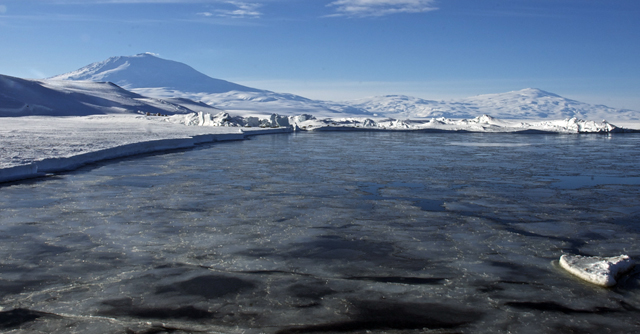Christchurch earthquakeWitnesses recall first days of crisis as search finds all USAP personnel are OKPosted March 18, 2011
Most people have seen the pictures of the crumpled Christchurch Cathedral or watched the video of a woman plucked from the roof of a collapsed building to safety by a fire crew. But was the destruction wrought by the 6.3-magnitude earthquake on Feb. 22 as bad as it looked in media reports? It was worse, said Mel Moore. Moore and his wife Sally Moore were among the hundreds of U.S. Antarctic Program (USAP) The Moores were in a small, cramped antique store in Christchurch’s central business district (CBD) when the ground started shaking and the lights went out. Mel Moore swatted a plate away that he saw falling toward his wife, as glass and ceramics crashed to the floor. After the earth stopped moving, the Moores and the shop owner, bleeding from a head wound, attempted to leave the store. “The way out was blocked by all the bookcases that had fallen over and the broken debris. The owner said not to worry about breaking anything, just get us out of the shop. As Sally says, I went into ‘Mel-dozer’ mode and quickly cleared a trail,” said Mel Moore, a man who would size up well on an NFL offensive line. Once outside, the scene was chaotic. Sirens and alarms echoed around the city; the air was filled with dust. Amid the confusion, the Moores eventually headed to the safety of the open space at Victoria Square. USAP offices go into actionLess than two hours after the quake struck, the first situation report — a sitrep, in military slang, which still dominates the U.S. Antarctic Program from its days when the U.S. Navy ran logistics on the Ice — came out of the program’s offices in Christchurch. All of the local New Zealand staff who works for the USAP at a facility near the city’s international airport had already been accounted for and were safe. Kerry Chuck, manager of the New Zealand Operations, reported that nearly 600 people in the USAP, including military personnel associated mainly with flight operations, were believed to be in the area. The e-mail went out to officials at the National Science Foundation (NSF) RPSC immediately established a “command center” in its Denver office, and the search began for about 600 people who could be anywhere in the city or South Island. Several Raytheon employees would spend the night at the office to begin organizing a plan to evacuate everyone from the area in coordination with the staff in Christchurch. “As I was about to hit the send button, we have had another severe shock,” Chuck’s message concluded. Caught in an avalancheThe aftershocks motivated Chad Naughton to get as far away as possible from the city streets and the surrounding buildings, as he stood stunned, bruised and bleeding after being pulled to safety from under a pile of bricks. Only moments before, he had been in a map shop on the corner of Gloucester and Manchester streets, talking to an employee about possible hiking spots. Then the sound started, as Naughton remembers it. “It was incredible, a low grumbling sound that immediately turned into a very loud, very real, frightening banging and crashing that kept getting louder and louder. The ground was moving in all directions.” He made the decision to sprint out the front entrance as ceiling tiles and lights crashed around him, running toward a white car parked outside, as the bricks on the building’s façade came down in an avalanche. 
Photo Credit: Chad Naughton
The parked car that may have helped save Chad Naughton's life as he ran underneath an avalanche of bricks.
“That classy lil’ number may have just saved my life,” said Naughton, who works as a science planner for RPSC. “It created a triangle of space that saved me from the full impact of the falling debris. If I was three feet to the right, or that car was not parked there, I fear I may not have been so lucky. I ended up buried under some bricks with my head in the street.” The next thing he heard was a voice in a German-sounding accent asking him if he was OK. The man helped Naughton to the middle of the street. Naughton was bleeding from the back of his head, and his knee was throbbing. But he was alive. And then the first aftershock came. “Imagine standing on something like the ground, which we normally trust, and now it is doing everything it can to knock you down,” Naughton said. “This one was over as soon as it started — thankfully. I looked around, and noticed a tall building on every corner and decided it was time to walk to a safer place.” He started following a herd of people toward Latimer Square. Storms pummel McMurdo StationMeanwhile, back at McMurdo Station 
Photo Credit: Ryan Wallace
The ice edge in early March near Scott Base. Mount Erebus is in the background at left.
The sea ice It got it. A major storm howled through the region for about three days, clearing the Sound of ice and even chipping away at the permanent McMurdo Ice Shelf where a snow road and fuel line run out to Pegasus airfield Station personnel would be busy for several days digging out of the storm and securing the fuel tanks where the cracking of the ice shelf was getting uncomfortably close. And, of course, they were worried about friends in Christchurch, some of whom had flown out just a couple of days before the earthquake.1 2 3 Next |



For USAP Participants |
For The Public |
For Researchers and EducatorsContact UsNational Science FoundationOffice of Polar Programs Geosciences Directorate 2415 Eisenhower Avenue, Suite W7100 Alexandria, VA 22314 Sign up for the NSF Office of Polar Programs newsletter and events. Feedback Form |


